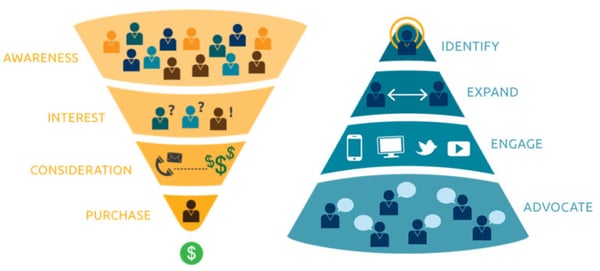November 5, 2025
 by Claire Brenner / November 5, 2025
by Claire Brenner / November 5, 2025

Would you rather be addressed as “Hey there” or by your name?
An easy guess: it’s the latter. Your customers want personalization, too. Nobody wants to feel like just a number; they want to feel important.
Today, mass marketing isn’t as effective as it once was, since consumers are now empowered with information. Account-based marketing (ABM) takes a different approach from trying to appeal to the masses. In fact, it’s the opposite.
Account-based marketing targets specific high-value accounts with personalized campaigns instead of broad outreach. ABM aligns marketing and sales to engage decision-makers at key companies, increase conversion rates, and shorten sales cycles in B2B environments.
This comprehensive guide will cover everything you need to know about account-based marketing, the basics, the strategies, and how marketers can use account-based analytics software to target the right prospect.
Read on to learn why account-based marketing is not just personal but profitable.
In recent years, customers have become significantly more empowered. They’re no longer limited to the information presented in a sales pitch. Rather, thanks to the wealth of information available via the internet and customer reviews, customers can begin their own product research before ever contacting a company.
of marketers identify high-quality lead generation as their biggest challenge.
Source: Demand Sage
What does that really mean?
A lot of the B2B website visitors are not potential customers. Traditional efforts to reach every single site visitor and convert them into a lead do not work. For as much human energy and financial resources marketing executives throw into this, there is a lack of qualified leads being sent to the sales team.
Account-based marketing and account-based experience are much-needed alternatives. By identifying the accounts that are most valuable to the businesses, marketing and sales teams can narrowly focus their resources for higher financial gain.
Another advantage of ABM is that it makes room for a more trusting vendor-customer relationship, one that better benefits both parties in the long run.
While traditional marketing dates back to the printing press in 1450 and beyond, account-based marketing is a much more recent trend, dating back to the early 1990s. At this time, both B2B and B2C companies recognized a need for marketing that focused on personalization over appealing to the masses.
However, Don Peppers and Martha Rogers formally introduced the concept when they published The One to One Future: Building Relationships One Customer at a Time in 1993. This book, referred to by Business Week as “the bible of new marketing,” was a well-known and respected prediction of the transition from the mass marketing approach to the more personalized one-to-one marketing.
The book encouraged marketing and sales teams to seek out the small percentage of their customers that offered the greatest financial gain. Then, to work individually with each customer and establish a personalized nurture plan for each.
However, it wasn’t until 2003 that the term account-based marketing was coined. The Information Technology Services Marketing Association (ITSMA) elaborated on the concept when it published its groundbreaking paper, Account-Based Marketing: The New Frontier, giving a name to the emerging marketing trend just 10 short years after Peppers and Rogers initially introduced it.
ABM looks very different in the present, with relationships being developed and tended to by email, team collaboration tools, and video conferencing software. Specifically, the rise of CRM software has made it easier to track the particular traits, wants, and needs of individual customers.
If you’re ready to put ABM strategy into action, explore this breakdown of the best account-based software to support targeting, personalization, and execution.
There are three types of account-based marketing: strategic ABM, ABM lite, and programmatic ABM.
Strategic ABM, or the one-to-one method, is the original approach to account-based marketing — the strategy Peppers and Rogers referred to in their groundbreaking book. It typically requires the most marketing resources but delivers the highest return on investment.
One-to-one ABM is usually spearheaded by one or two key members of an organization’s marketing team and directed toward the most valuable clients, the 10 percent of clients that are likely to bring your sales team the six-figure deals they’re after. These clients also represent the greatest churn risk and the largest upsell opportunity, which is why targeting them with hyper-personalized campaigns is of the utmost importance.
ABM lite, or one-to-few account-based marketing, is a method targeted to small groups of key accounts that have similar characteristics and needs. While following the same principles as strategic ABM, it requires a lower financial commitment and is likely spearheaded by mid-level marketers and salespeople.
This strategy targets key accounts with lower revenue or upsell potential than the accounts you’re targeting individually. For example, say 30 percent of your target accounts have the same revenue potential as the 10 percent we mentioned above. You would reach out to that 30 percent via ABM lite.
Companies may be grouped based on industry, business size, or problems they’re facing — often a mixture of all three. The campaign could be slightly customized per individual company, but will remain mostly consistent across the board.
Programmatic ABM, or one-to-many account-based marketing, is the newest approach to ABM. It’s the practice of scaling ABM to a multitude of accounts, which has been made possible by recent technologies. Not to be confused with segmented or traditional marketing, the one-to-many approach is still targeted; it merely uses larger clusters of accounts.
Through email marketing campaigns, paid social media targeting, and more, one marketer can reach hundreds or even thousands of different accounts. The company will likely have little to no customization, but rather a single campaign that touches the accounts’ general wants and needs.
The key to implementing a programmatic ABM approach is balance. You want to reach a large enough audience to see results, but narrow it down so that your messaging is still applicable to the accounts you target.
Use this quick guide to match strategy to account potential and resources.
Tip: Most teams layer these models together, starting wide with programmatic, then narrowing focus with Lite or Strategic ABM based on engagement.
Consider this: you’re a marketer at a social media monitoring software company looking to acquire a B2C client that’s a household name.
Your product provides brand functionality for listening and tracking relevant content across various social media platforms. You know this customer could be a significant source of revenue, so your team designates a fair amount of resources for its particular campaign.
To play off of your product’s listening functionality, you buy 11 pairs of fancy new headphones for the decision-makers you’ve decided to target. You send them along with a note that says, “Having trouble listening to what your customers are saying on social media?” and a fully personalized sales deck describing exactly how your product can help.
If this campaign pays off or at least gets your salesperson’s foot in the door, it will be money well spent.
It’s true that ABM is a sophisticated strategy that requires numerous moving parts. That said, there are a few steps you should take to ensure the best results from your campaign.
If you’re entirely new to account-based marketing, then the first step is obvious: assemble your ABM team! This will look different depending on the type of company for which you work. If both your marketing and sales teams are built out, it’s more likely that a few employees can devote the majority of their time to ABM.
These employees may come from a variety of backgrounds within these two teams. Content marketers, marketing operations managers, and field marketers can all be great additions to this team. Having a marketing-focused graphic designer is always a plus, as well.
On the sales side, a sales or business development representative is a must-have. They can be critical in executing research to determine key accounts and the decision-makers at a prospective company. Additionally, you’ll want to recruit some top account executives, the ones trusted to close those six-figure deals.
You probably learned this back in middle school, but as a reminder, you should never start a project without first defining your goals. This is especially true when beginning an ABM strategy.
Once you’ve assembled your team, you can sit down and discuss what you’re aiming to achieve. Ask yourself some questions. For example, what percentage of new business is marketing expected to drive? What are the ABM-specific revenue goals? How many MQLs are the marketing team expected to pass through to sales?
Discuss these questions (and more!) with your team. Use the answers to set your goals, and as you’re beginning to document your ambitions, don’t forget: goals should be SMART. By that, we mean Specific, Measurable, Achievable, Realistic, and Time-bound.
When you’ve determined your goals, you can begin working on your strategies to achieve them.
Now that you’ve assembled your team and documented your goals, we’ll start working on the tactical level.
ABM is all about personalizing each campaign by account. Before you can customize initiatives, you have to know to whom they’re directed!
To determine your target accounts, you’ll want to look at the companies that could provide you with the highest possible revenue. However, a one-time deal isn’t all that you're seeking. Consider the growth potential of each company. Will you be able to upsell them in the future? Even more importantly, do they have a high churn risk?
When you determine your key accounts, you’ll dig in even deeper by identifying the employees there with the purchasing power. Frankly, who you’re selling to depends on what you’re selling.
If your offering is a marketing automation tool, perhaps you’ll want to seek out the chief marketing officer, director of marketing, and marketing operations manager. Try to find a balance between the high-level employees who will use the software as well as those who manage the team’s budget. When you identify these people, you’ll know where to focus your marketing efforts.
Alright, you’ve identified your target accounts and narrowed down the decision-makers. At this point, you’ll begin your marketing efforts.
When you get to this step, it’s important to determine which type of ABM may be best suited for each prospect. Remember earlier, when we discussed the difference between strategic ABM, programmatic ABM, and ABM lite?
Consider your audience and the potential deal. If you’re targeting just five high-impact accounts, you may opt for a personalized strategic ABM campaign, customized to each company in particular.
On the other hand, if you’re reaching out to a larger audience, ABM lite may be a better choice. This step is all about execution. Whether it’s a direct mailer, paid social media ads, or anything in between, this is when you’ll begin outreach and start the conversation.
If you successfully completed the last step, this should (hopefully) be easy. That’s right, it’s time for the sales team to step in.
ABM is all about making sales conversations more productive. Once you’ve finished your marketing outreach, your account executives should be armed with all they need to reach out to their key prospects. By focusing marketing efforts on the decision-makers, you’ve given them a head start in sealing the deal.
That said, making the sale isn’t everything. In fact, the purchasing process used to end here, but not anymore! Once the contract is signed, we’ll move on to the next step: turning customers into advocates.
This step is what account-based marketing is all about.
While making sales and generating revenue is important (duh), ABM’s primary function is to build relationships. If the goal is to form a connection with your customers, turning them into advocates is how you’ll know you’ve achieved it.
Turning a paying customer into your company’s biggest fan may sound intimidating, but it’s not impossible. And while it isn’t easy, stellar customer service will get you started.
Continue being attentive to your customers' wants and needs after purchase. This will enable your team to increase its LTV and let customers know they’re more than just a number.
And if building relationships wasn’t motivation enough, remember that advocates can pay off in more ways than just one. In fact, according to Joseph Jaffe, ABM aficionado and author of Flip the Funnel, acquiring a customer through an existing customer costs just one-third as much as other methods of acquisition.
This is why account-based marketing is a loop, as opposed to a one-way street.
So, you’ve gone through the steps of your first account-based marketing strategy.
All done, right?
Well, almost. The final step is all about understanding just how well that strategy worked. The last stage of your ABM strategy is measuring success.
Success in account-based marketing can mean a few things. Obviously, it means revenue is secured, but as we mentioned earlier, the relationships you formed can be just as, if not more, critical.
Looking back at your performance and measuring success is vital to understanding what worked and what you’ll need to improve for next time.
That was a long process. That said, the more campaigns you implement, the easier it will be to get through those seven steps.
If you’re looking to make the process go even smoother, the next section is for you.
As we’ve mentioned throughout this guide, ABM focuses on four underlying principles: client centricity, sales and marketing alignment, relationship focus, and personalized campaigns. That said, as it has gained popularity over the years, different companies have developed various ways to approach it based on their size, resources, and target customers.
No single ABM method will be one-size-fits-all. In fact, most companies employ a combination of methods to ensure that they’re hitting all of the accounts that will push the needle on their revenue goals.
Similar to the types of ABM, companies can employ multiple tactics depending on the target they’re trying to reach. What it comes down to is this: the gifts, events, and online ads just get you in the door; it’s still up to your stellar sales team to seal the deal.
Traditional lead generation is a method often used in business-to-consumer (B2C) and B2B companies. The marketing funnel here is linear, where your audience starts at the wider end of the funnel and goes through the stages in order.
Some potential customers make it all the way through the funnel; most don’t. Many fall out along the way — even as late as the intent stage. Account-based marketing acknowledged that shortcoming and decided to flip the funnel instead.
The keyword here is target accounts. B2B marketers often have smaller audiences, which makes ABM an easier approach than traditional mass marketing. Marketers and sales teams use ABM on some of their high-stakes customers, the ones who have the potential to bring in the most revenue for the business.
It may seem like account-based marketers are fishing with a spear instead of a large net, like their mass-marketing counterparts, and that may be true. But think of ABM marketers using that spear to catch a 400-pound salmon when other marketers are coming away with a net full of 200 small trout.
Account-based marketers are looking for customers who will have the highest customer lifetime value (LTV). That means they’ll not only close a large deal from the start but also continue upselling them throughout the customer lifecycle.
Account-based marketing is like a subject line with your name in it, on a grander scale. It can be anything from a personalized sales deck to a campaign as massive as taking a group of executives skydiving.
To some, ABM sounds more straightforward than traditional marketing. Appealing to a select few is easier than to the masses, right?
Not exactly. In fact, identifying key companies, the decision-makers within them, and their wants and needs requires significant work, not to mention a lot of joint effort from marketing and sales. However, if it works in your favor, the rewards you reap will be more than worth it.
Ultimately, a lot of what account-based marketing comes down to is the Pareto Principle or the 80/20 rule. In its origination, the Pareto Principle related to land, when Italian economist Vilfredo Pareto found that 80% of Italian land was owned by 20% of the population. In ABM, it means that 80% of revenue comes from 20% of customers.
When you know which of your customers are included in that 20 percent, you can tailor your marketing efforts specifically toward them, and there it is: account-based marketing.
ABM isn’t the only buzz-worthy trend making its way through the marketing industry.
Inbound marketing, a term coined by HubSpot CEO Brian Halligan in 2005, has taken off in popularity since its inception. B2B marketers especially took the concept in stride starting in 2012, when the purchasing process began its transition to be more customer-centric.
Today, inbound is still gaining popularity, with HubSpot leading the way for a multitude of other B2B marketing teams.
However, there is a strong” us vs. them” mentality regarding inbound and account-based strategies. That said, using them in tandem can help marketers optimize their tactics. The mindset that one is superior to the other is simply untrue.
Inbound marketing is all about empowering your customers through organically found content. By producing content that feels valuable and informative, whether it’s blogs, social media posts, infographics, or more, you establish your business as a trusted and authoritative voice.
The inbound strategy doesn’t focus on interruption-based messages, which would include sending the content directly to customers, paid social ads, and more. Instead, it’s about optimizing the content to be found organically through search engines and social media.
As opposed to fighting for a customer’s attention, you’re letting them come to you through content that feels personalized, relevant, and helpful.
Inbound marketing has four stages: attract, convert, close, and delight.
As opposed to the traditional marketing funnel, the inbound approach is a loop. When you turn customers into advocates, they’ll reach out to their networks, turning them into visitors, and so on.

Source: CXL
With a basic understanding of inbound marketing, you can likely see how it differs from the account-based approach. While both types are customer-centric, account-based is about reaching out to the customer, whereas inbound focuses on letting the customer come to you.
However, that’s not the only area in which they differ. A significant area of difference between the two is scalability. In fact, the method a marketer chooses to use can likely depend on their audience size.
For example, if a B2B marketer at a niche software company is determining how to market their offering, they should consider the size of their audience. An inbound strategy may not be their best option. Regardless of how valuable content they produce, they won’t achieve their goals if there’s nobody to read it.
Similarly, marketers at companies with massive audiences may find inbound to be a more cost-efficient approach than account-based marketing. In fact, inbound champions may argue that using ABM to market to broad audiences will resemble the spammy approaches, precisely what inbound was created to counter.
Additionally, they differ based on deal size. Due to the goals and tactics associated with ABM, deal sizes are often larger. On the other hand, inbound deals closed may be smaller, but the deals themselves will likely be more plentiful.
Regardless of the differences, both inbound and ABM emphasize the customer's centrality. Both were created to empower the customer and act as alternatives to the traditional (and often sleazy) sales pitch.
Similarly, they are both driven primarily by valuable content. With inbound, this content is written to be an authoritative and educational resource. In account-based marketing, the content can range from a well-written nurture email to a thought-out social post and anything in between.
More importantly, you can combine inbound and account-based marketing to optimize your strategy.
Marketers can do this in multiple ways. If you are primarily using an inbound strategy, the content types you’ve already created can be your most significant resource. Repurposing past blog posts, infographics, eBooks, and more to target key accounts specifically is a simple and productive way to get through to some of your toughest potential customers.
On the other hand, you can use account-based insights to support your content ideation. If you know what content has influenced previous key accounts, you have a starting point for what you’ll produce in the future.
Similarly, you can leverage ABM techniques to follow up with readers who have turned into marketing-qualified leads through your inbound efforts. If you’ve received an office address through gated content, perhaps you can send the prospect a direct mail package.
As we mentioned before, the case for inbound versus ABM isn’t a this-or-that situation. When you use them together, they can bring you great success and help you acquire the loyal customers you’re seeking.
As mentioned before, account-based marketing can require B2B professionals to spend a significant chunk of change. Seeing desired financial results is critical to the success of an ABM strategy, but they certainly aren’t its only draw. In fact, the benefits of account-based marketing are plentiful.
With the above benefits, it’s obvious why so many B2B marketing teams are beginning to embrace account-based marketing strategies. If you’re considering implementing ABM into your marketing mix, the next section will give you the steps you’ll need to take to get started successfully.
Even with the benefits, there are a few challenges around finding the right lead, and a lack of tools and budget may act as a roadblock for marketers new to the strategy.
Software, when implemented correctly, can be a key asset to the success of your account-based marketing strategy.
Today, there are multiple tools within the greater realm of account-based marketing software. G2 hosts five separate categories: account-based analytics software, account-based data software, account-based execution software, account-based orchestration platforms, and account data management software.
Each tool serves a different function in an ABM strategy. Overall, account-based marketing software assists in realigning marketing and sales departments. As with many software tools, ABM software heavily focuses on task automation. In this case, the tools can automate and reduce the lengthy process of identifying prospects and dedicating resources to nurture them.
Let's examine the various categories within ABM software and provide a brief overview of their primary functions.
I’m sure we don’t need to repeat this, but in case you’ve somehow forgotten, ABM is all about personalization.
Account-based execution software facilitates the customization marketers need to execute their ABM strategies.
This software is used by marketing teams to more efficiently assemble the custom messaging they need to deliver to each account. With these tools, users can create targeted content and deliver it to key targets on an account-by-account basis.
These products primarily function to improve the quality of leads that enter the sales pipeline. Customizing marketing efforts increases the likelihood that a sales conversation will be successful and saves marketing teams from spending unnecessary resources on prospects that won’t lead to a sale.
Often, these tools can integrate with marketing account management or marketing account intelligence software products.
Remember how much we stressed the importance of measuring the results of your ABM campaigns?
That’s where account-based analytics software comes in.
The software offers marketing and sales teams valuable metrics about the performance of their ABM strategies. For example, these tools provide insights such as the percentage of target accounts reached, account mapping, and lead-to-opportunity conversion rates.
When analyzed altogether, these metrics enable professionals to see the efficacy of their account-based marketing strategy.
To compile these results, account-based analytical software integrates with a company’s sales database. The database provides them with the information they need to deliver feedback in the form of metrics.
G2 helps businesses find the best account-based analytics tools for tracking target account engagement, measuring ABM performance, and optimizing revenue impact with precision.
Below are the five best account-based analytics software, based on G2’s Winter 2026 Grid Report.
Account data management software is a major asset to any ABM strategy. Understanding where key prospects are in their purchasing process is vital, and these software tools give professionals that insight and much more.
The software tracks prospect data throughout the entire ABM campaign. This means marketing and sales professionals have increased visibility into where each account is in the pipeline.
Documentation of this relevant information enables communication between sales and marketing teams. With this knowledge, professionals can understand who needs to devote efforts and where, as opposed to blindly guessing and over- or under-nurturing certain prospects.
Overall, account data management software maximizes efficiency. The increased transparency it provides helps sales and marketing organizations remain aligned, preventing the waste of resources and efforts.
G2 helps marketing and sales teams discover the best account data management tools for centralizing prospect data, improving segmentation, and driving more personalized ABM campaigns.
Below are the five best account data management software, based on G2’s Winter 2026 Grid Report.
When implementing an ABM strategy, it’s important that marketing and sales professionals take the time to develop the list of prospects that will become their “key accounts.” As we’ve mentioned throughout this guide, these are the accounts that have the highest revenue potential and are most likely to become loyal advocates.
That said, developing this list isn’t easy. In fact, it takes a lot of time for marketing and sales professionals alike to do this.
Account-based data software strives to simplify this process. These tools collect insightful and detailed target account data from external sources and then use that data to develop a list of critical targets.
This data is much more valuable than just an email address or phone number. In fact, it can identify where specific employees are in the company hierarchy or what segment they work in, singling out the accounts with a high probability of converting.
This data enables the software to score or rank leads, better connecting marketers with prospective accounts. Ultimately, these tools will save you time and allow marketers to get a head start on their ABM campaigns.
Account-based orchestration platforms manage different components of ABM campaigns, like a conductor directing an orchestra.
An ABO platform lets you manage different campaign components, such as account identification, targeting, and optimizing strategies, through a centralized system to create a symphony that resonates with the target accounts.
These systems use buyer intent and behavioral data to segregate and prioritize the most-promising accounts, further helping manage the ABM efforts.
G2 helps B2B teams choose the best account-based orchestration tools to coordinate campaigns, unify buyer insights, and scale personalized outreach across channels.
Below are the five best account-based orchestration platforms, based on G2’s Winter 2026 Grid Report.
Marketing is an industry infiltrated with jargon, and account-based marketing is no different! In this brief section, we’ll provide an overview of the terms you need to know and how they relate to the bigger ABM picture.
Account-based marketing is all about identifying those key accounts that will really push the needle on your revenue goal. These accounts are called “ideal customers.” Your ideal customer is based on a profile you develop and should be representative of the group whose problem your offering was built to solve. Building your ideal customer profile is a critical step in determining the language you’ll use throughout your marketing efforts.
Smarketing may not be an actual word, but what it represents is very real. Smarketing is the concept of aligning sales and marketing teams to improve communication and optimize efforts on both sides.
Smarketing is vital to account-based marketing, as sales and marketing teams work very closely throughout your ABM strategy. Ensuring that your sales and marketing teams remain in sync will improve efficiency and likely increase revenue.
A marketing-qualified lead, often referred to as an MQL, is a lead that has been determined to have a greater likelihood of converting into a customer. They’re called marketing-qualified leads because they are typically evaluated based on a set of parameters put in place by your organization’s marketing team.
MQLs are an important aspect of account-based marketing because, typically, these are the leads that have been nurtured with a personalized campaign. When a marketing professional passes an MQL on to their sales counterpart, it’s likely the prospect(s) at that company are ready and willing to sit down and have a conversation.
While this can mean different things in different companies, we’ve used it to refer to those employees with the actual purchasing power. Often, this is more than just one employee.
Typically, purchasing power will lie predominantly in the hands of the department chair. For example, if you’re trying to sell marketing automation software to a marketing team, your decision-maker will likely be the CMO.
However, it’s also important to remember the people who may hold the purse strings, often the chief financial officer or chief operating officer. These may also be decision-makers, so it’s important to think beyond the department when you’re determining where to focus your marketing efforts.
Got more questions? We have the answers.
Yes. Small and midsize businesses can start with ABM Lite or programmatic ABM using intent data and cost-effective tools, then scale personalization as resources allow.
ABM success is measured by account-level metrics, such as engagement score, deal velocity, pipeline influence, and customer lifetime value, rather than just lead volume. Alignment between marketing and sales is a key success factor.
ABM is especially effective in industries with long sales cycles, high contract values, and complex buying committees, such as SaaS, financial services, healthcare, manufacturing, and B2B technology.
ABM is ideal when your business has a clear ideal customer profile (ICP), a long or complex sales cycle, and the resources to personalize outreach for key accounts. It’s most impactful when marketing and sales are ready to collaborate closely.
Demandbase, 6sense, and HubSpot are top-rated orchestration apps known for their strong user reviews. They excel in streamlining marketing efforts, audience targeting, and automation. Explore this listicle on the 5 best account-based orchestration platforms to review top tools, including their pros, cons, and user reviews.
Account-based marketing is a long-term strategy. Building relationships with high-value key accounts takes time and effort. Once you start creating ABM campaigns, stay committed to personalizing messages, refining strategies, and developing meaningful and deeper relationships. Doing that, you'll see the payoff is much more than the initial struggle.
Learn how intent data powers smarter targeting in this B2B intent data guide.
This article was originally published in 2018. The content has been updated with new information.
Claire is a former growth marketing team manager at G2. Born and raised in the Chicago area, her brief stint in Ohio (University of Dayton) gave her a new appreciation for deep-dish pizza, but left her well-versed in Cincinnati-style chili and "cities" with a population fewer than 400,000. While not writing, Claire can be found practicing calligraphy, seeking out the best dive bars in Chicago, and planning her next trip. (she/her/hers)
Marketing and sales teams talk a lot about alignment, but in practice, it rarely happens.
 by Harshita Tewari
by Harshita Tewari
Starting an account-based marketing program from scratch can sound intimidating. The good news...
 by Joel Garcia
by Joel Garcia
Account-based marketing (ABM) has become a cornerstone of B2B marketing, revolutionizing how...
 by Sagar Joshi
by Sagar Joshi
Marketing and sales teams talk a lot about alignment, but in practice, it rarely happens.
 by Harshita Tewari
by Harshita Tewari
Starting an account-based marketing program from scratch can sound intimidating. The good news...
 by Joel Garcia
by Joel Garcia


